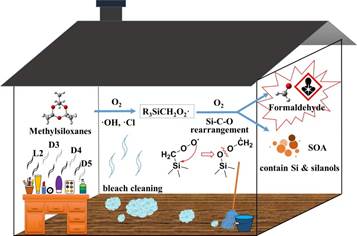Date:Jun 15, 2020
Source:School of Environmental Science and Technology
By Li Xiang, Xie Hongbin
Recently, Prof. Xie Hongbin’s team from School of Environmental Science and Technology published important research work entitledFormation of Low-Volatile Products and Unexpected High Formaldehyde Yield from the Atmospheric Oxidation of MethylsiloxanesinEnvironmental Science & Technology (DOI: 10.1021/acs.est.0c01090), an international authoritative journal in the field of environment.

With stricter regulation of atmospheric volatile organic compounds (VOCs) originating from fossil fuel-based vehicles and industries, the use of volatile chemical products (VCPs) and the transformation mechanism of VCPs have become increasingly important to quantify air quality. Volatile methylsiloxanes (VMS) are an important class of VCPs and high-production chemicals. Using quantum chemical calculations and kinetics modeling, the team investigated the reaction mechanism of peroxy radicals of VMS, which are key intermediates in determining the atmospheric chemistry of VMS. L2-RSiCH2O2• and D3-RSiCH2O2• derived from hexamethyldisiloxane and hexamethylcyclotrisiloxane, respectively, were selected as representative model systems. The results indicated that L2-RSiCH2O2• and D3-RSiCH2O2• follow a novel Si–C–O rearrangement-driven autoxidation mechanism, leading to the formation of low volatile silanols and unexpected high yield of formaldehyde at low NO/HO2• conditions. At high NO/HO2• conditions, L2-RSiCH2O2• and D3-RSiCH2O2• react with NO/HO2• to form organic nitrate, hydroperoxide, and active alkoxy radicals. The alkoxy radicals further follow a Si–C–O rearrangement step to finally form formate esters. The novel Si–C–O rearrangement mechanism of both peroxy and alkoxy radicals are supported by available experimental studies on the oxidation of VMS. Notably, the high yield of formaldehyde is estimated to significantly contribute to formaldehyde pollution in the indoor environment, especially during indoor cleaning.

Prof. Xie Hongbin is a doctoral supervisor of School of Environmental Science and Technology at DUT. After graduating from Jilin University in 2008, he did postdoctoral research at University of Pittsburgh and University of California at Irvine. He started working at Dalian University of Technology in 2012, mainly engaged in environmental computational chemistry research. In recent years, he has published more than 70 papers indexed by SCI in international journals, including 8 papers inEnvironmental Science & Technology and Atmospheric Chemistry and Physics.
Editor: Li Xiang